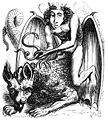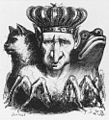Dictionnaire Infernal
This article possibly contains original research. (September 2007) |
The Dictionnaire Infernal (Template:Lang-en) is a book on demonology, organised in hellish hierarchies. It was written by Jacques Auguste Simon Collin de Plancy and first published in 1818. There were several editions of the book, but perhaps the most famous is the edition of 1863, in which sixty-nine illustrations were added to the book. These illustrations are drawings which try to depict the descriptions of the appearance of several demons. Many of these images were later used in S. L. MacGregor Mathers's edition of The Lesser Key of Solomon though some of the images were removed.
The book was first published in 1818 and then divided into two volumes, with six reprints and many changes between 1818 and 1863. This book attempts to provide an account of all the knowledge concerning superstitions and demonology.
A review in 1822 read:
Anecdotes du dix-neuvième siècle ou historiettes inédites, anedoctes récentes, traits et mots peu connus, aventures singulières, citations, rapprochements divers et pièces curieuses, pour servir à l'histoire des mœurs et de l'esprit du siècle où nous vivons comparé aux siècles passés Anecdotes of the nineteenth century or stories, recent anecdotes, features and little known words, singular adventures, various quotations, compilations and curious pieces, to be used for the history of the customs and the mind of the century in which we live, compared with centuries past.
The cover page for the 1826 edition reads:
Dictionnaire infernal ou Bibliothèque Universelle sur les êtres, les personnages, les livres, les faits et les choses, qui tiennent aux apparitions, à la magie, au commerce de l'enfer, aux divinations, aux sciences secrètes, aux grimoires, aux prodiges, aux erreurs et aux préjugés, aux traditions et aux contes populaires, aux superstitions diverses, et généralement à toutes les croyances merveilleuses, surprenantes, mystérieuses et surnaturelles Infernal Dictionary, or, a Universal Library on the beings, characters, books, deeds, and causes which pertain to the manifestations and magic of trafficking with Hell; divinations, occult sciences, grimoires, marvels, errors, prejudices, traditions, folktales, the various superstitions, and generally all manner of marvellous, surprising, mysterious, and supernatural beliefs.
Influenced by Voltaire, Collin de Plancy initially did not believe in many superstitions. For example, the book reassures its contemporaries as to the torments of Hell: "To deny that there are sorrows and rewards after death is to deny the existence of God; since God exists, it must be necessarily so. But only God could know the punishments meted out to the guilty, or the place that holds them. All the catalogues made herebefore are only the fruit of a more or less disordered imagination. Theologians should leave to the poets the depiction of Hell, and not themselves seek to frighten minds with hideous paintings and appalling books"(p. 164).[1]
But the skepticism of Collin de Plancy grew blurred with time. By the end of 1830 he surely becomes an enthusiastic Catholic, to the consternation of his former admirers.
In later years, De Plancy rejected and modified his past works, thoroughly revising his Dictionnaire Infernal to put it in conformity with the canons of the Roman Catholic Church. This influence is most clearly seen in the sixth and final 1863 edition of the book, which is decorated with many engravings and seeks to affirm the existence of the demons. Collin de Plancy finished his career with a collaboration with the Abbé Migne to complete a Dictionary of the occult sciences or theological Encyclopaedia, described by some as an authentic work of Roman Catholic doctrine.[2][3]
Many articles written in the Dictionnaire Infernal illustrate the author's vacillation between rationalism, faith and willingness to believe without evidence. For example, he admits the possible effectiveness of chiromancy, while rejecting cartomancy: "It is certain that chiromancy, and especially physiognomy, have at least some plausibility: they draw their predictions from signs which relate to features which distinguish and characterize people; of lines which the subjects carry with themselves, which are the work of nature, and that someone can believe significant, since they are unique to each individual. But the cards, merely human artifacts, not knowing either the future, nor the present, nor the past, have nothing of the individuality of the person consulting them. For a thousand different people they will have the same result; and consulted twenty times about the same subject, they will produce twenty contradictory productions"(p. 82).[1]
List of demons
- perrow="5"
- Abigor also known as Eligos
- Abraxas-Abracas
- Adramelech
- Aguares
- Alastor
- Alocer
- Amduscias
- Amon
- Andras
- Asmodee
- Astaroth
- Azazel
- Bael
- Balan
- Barbatos
- Behemoth
- Belphegor
- Belzebuth
- Berith
- Bhairava-Beyrevra
- Buer
- Caacrinolaas
- Cali
- Caym
- Cerbere
- Deumus Deimos
- Eurynome
- Flaga
- Flavros
- Forcas
- Furfur
- Ganga-Gramma
- Garuda
- Guayota
- Gomory
- Haborym
- Ipes
- Lamia
- Lechies
- Leonard
- Lucifer
- Malphas
- Mammon
- Marchosias
- Melchom
- Moloch
- Nickar
- Nybbas
- Orobas
- Paimon
- Picollus
- Pruflas/Busas
- Rahovart
- Ribesal
- Ronwe
- Scox
- Stolas
- Tap
- Torngarsuk
- Ukobach
- Volac
- Wall
- Xaphan
- Yan-gant-y-tan
- Zaebos
Editions
- Dictionnaire Infernal – ISBN 2-264-02956-0
References
External links
- Dictionnaire infernal: ou Répertoire universel des êtres, des personnages, 1853 582 pages – at Google Books PDF download available
- Dictionnaire infernal, ou, Recherches et anecdotes, sur les démons, les, 1818 at Google Books, PDF download available
- Dictionnaire infernal, ou Recherches et anecdotes sur les démons, 1844 at Google Books, PDF download available
- Dictionnaire des sciences occultes: ou, Répertoire universel des êtres, des, 1848 at Google Books, PDF download available
- Deliriums Realm – Dictionnaire Infernal
- Boards of the edition of 1826 on the site of the electronic library of Lisieux






